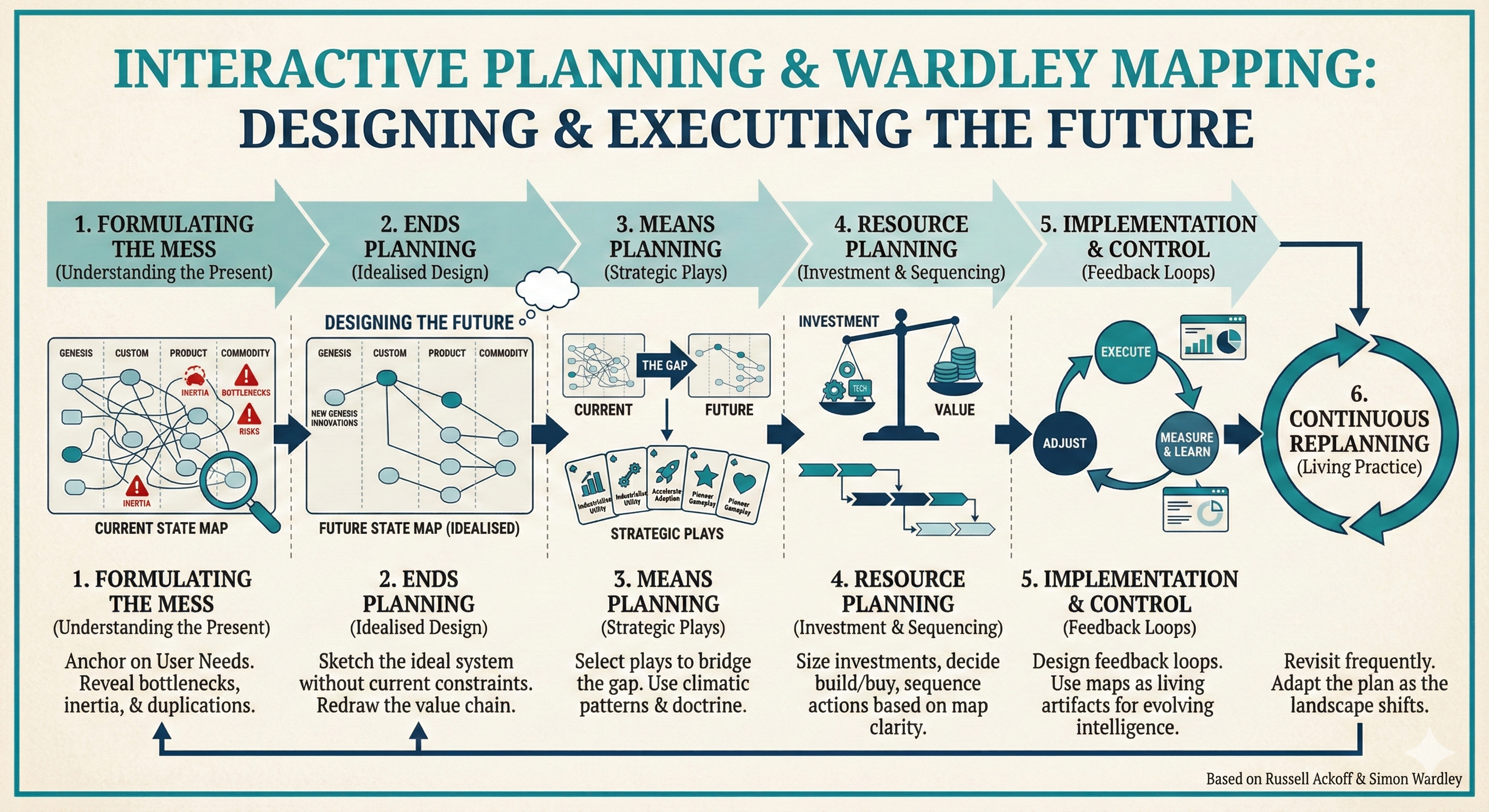Interactive Planning, Idealised Design, and Wardley Mapping
In our last post, we explored how Soft Systems Methodology can help us make sense of messy, contested situations. We saw how SSM allows us to negotiate a shared understanding of a problem space, creating a foundation for purposeful action. But how do we move from understanding the present to designing a better future?
Russell Ackoff's interactive planning and Wardley Mapping both ask leaders to design the future, not just forecast it. Together, they give teams the narrative, visual, and strategic tools to make that future a reality. Idealised design sketches the destination, while maps expose the terrain we must cross and the moves that will get us there.

Interactive Planning Reframes How We Plan
Ackoff argued that most organisations get stuck in one of three unhelpful postures: reactive (fixing yesterday's pain), inactive (assuming tomorrow will be like today), and preactive (predicting trends and hoping for the best). Interactive planning rejects all three. It invites everyone affected by a system to co-design a desirable future that is technologically feasible, and then to work backwards to the present, step by step.
The methodology has six interconnected phases:
- Formulating the mess: Develop a shared, multi-perspective understanding of how the current system performs, where it fails, and what external forces are shaping it.
- Ends planning: This is an idealised design exercise. Imagine the system was destroyed overnight and you could rebuild it from scratch today. What purpose would it serve? Which user needs would it prioritise? What principles would guide it?
- Means planning: Identify the major changes in capability, policies, and initiatives required to move from the current reality toward the ideal design.
- Resource planning: Determine the financial, human, and technological investment required and how to sequence it.
- Implementation and control: Design feedback loops so that you can learn and adjust as you go.
- Continuous replanning: Revisit the plan frequently. Interactive planning is a living practice, not an annual ritual.
Because this work is participative and democratic, the plan becomes the group's shared story of the future. This social contract is the real fuel for change.
Wardley Maps Make the Mess and the Ideal Visible
Wardley Maps complement each phase of interactive planning by turning assumptions into a visual landscape:
- Formulating the mess becomes a mapping exercise where teams anchor on user needs and the components that fulfil them. This reveals bottlenecks, inertia, duplicated effort, and dependency risks.
- Ends planning translates the idealised design into a future-state map. You can redraw the value chain as it should look, showing which components will vanish, which will evolve, and what new needs or practices will appear.
- Means planning transforms the gap between the present and future maps into a portfolio of strategic plays. This includes doctrine to industrialise utilities, climatic awareness to time market entries, and context-specific moves to unseat competitors or accelerate adoption.
- Resource planning uses the component-level clarity of the map to size investments, decide between building and buying, and choose where to apply partnerships or platform plays.
- Implementation and control use maps as living artifacts. As components evolve or new intelligence arrives, teams update the map and revisit the plan, keeping the entire practice interactive.
In short, interactive planning tells us why and who should design the future, while Wardley Mapping illustrates what that future looks like and how to get there.
Worked Example: Rebuilding a Telehealth Service
Imagine a national health provider whose telehealth service buckled under a surge in demand. The leadership convenes clinicians, operations staff, patient advocates, and technology teams for an interactive planning sprint.
- Formulating the mess with maps: Participants create a current-state Wardley Map anchored on the user need to "receive timely clinical advice." The map highlights legacy call-centre infrastructure (a utility, but brittle), manual triage scripts (a custom-built product), and missing components like asynchronous messaging or AI-assisted triage. Notes on inertia flag regulatory compliance delays and clinician burnout.
- Ends planning through idealised design: The group suspends current constraints and sketches the telehealth system they would build today. The future-state map features self-service symptom checkers (a product moving toward utility), AI-supported triage (evolving from a genesis experiment to a reliable product), integrated electronic health records (a utility), and redesigned practices for clinician scheduling and escalation.
- Means planning as gameplay selection: Comparing the two maps exposes the gap. The leadership sequences their plays: accelerate the commoditisation of call routing via cloud utilities, run discovery work on AI triage (a 'pioneer' gameplay), and partner with a regulated identity provider to satisfy compliance sooner. Their awareness of climatic patterns shapes their timing—for example, the pattern "market evolution eats bespoke triage" warns them to automate before a competitor does.
- Resource planning: With the value chain made explicit, the team can size the investment: redeploying 20% of call-centre staff to digital onboarding, securing funding for AI safety validation, and negotiating capacity with cloud vendors.
- Implementation and control: Delivery teams maintain both maps, updating the evolution of components every fortnight. When AI triage proves to be viable, the map signals a doctrinal shift: standardise training, codify feedback loops, and scale the utility across different regions.
The result is not a static roadmap but a living system. The map acts as the control surface for the idealised design, and the interactive planning cadence ensures that every stakeholder stays engaged as the terrain shifts.
Making the Combination a Leadership Habit
To embed this practice:
- Co-design maps in workshops: Interactive planning thrives on participation. Facilitate sessions where stakeholders can co-create current and ideal maps, capturing assumptions and disagreements in real time.
- Publish both maps and the narrative: Document the story that links the mess, the ideal, and the chosen strategic plays. Make it accessible so that new team members can get up to speed quickly.
- Revisit at least quarterly: Schedule replanning sessions where teams can refresh their intelligence, re-run critical gameplay choices, and retire components that no longer differentiate them.
- Measure learning velocity: Track how fast components move along the evolution axis compared to your expectations. Any deviations can become triggers for new interactive planning cycles.
Wardley Mapping gives interactive planning its cartography; interactive planning gives Wardley Mapping its social contract. Together, they help leadership design futures that are worth committing to—and then navigate the journey with confidence.
References
- Ackoff, Russell L. “A Brief Guide to Interactive Planning and Idealized Design.” Linköping University.
- Ackoff, Russell L.; Magidson, Jason; and Addison, Herbert J. Idealized Design: Creating an Organization’s Future. Prentice Hall, 2006.
